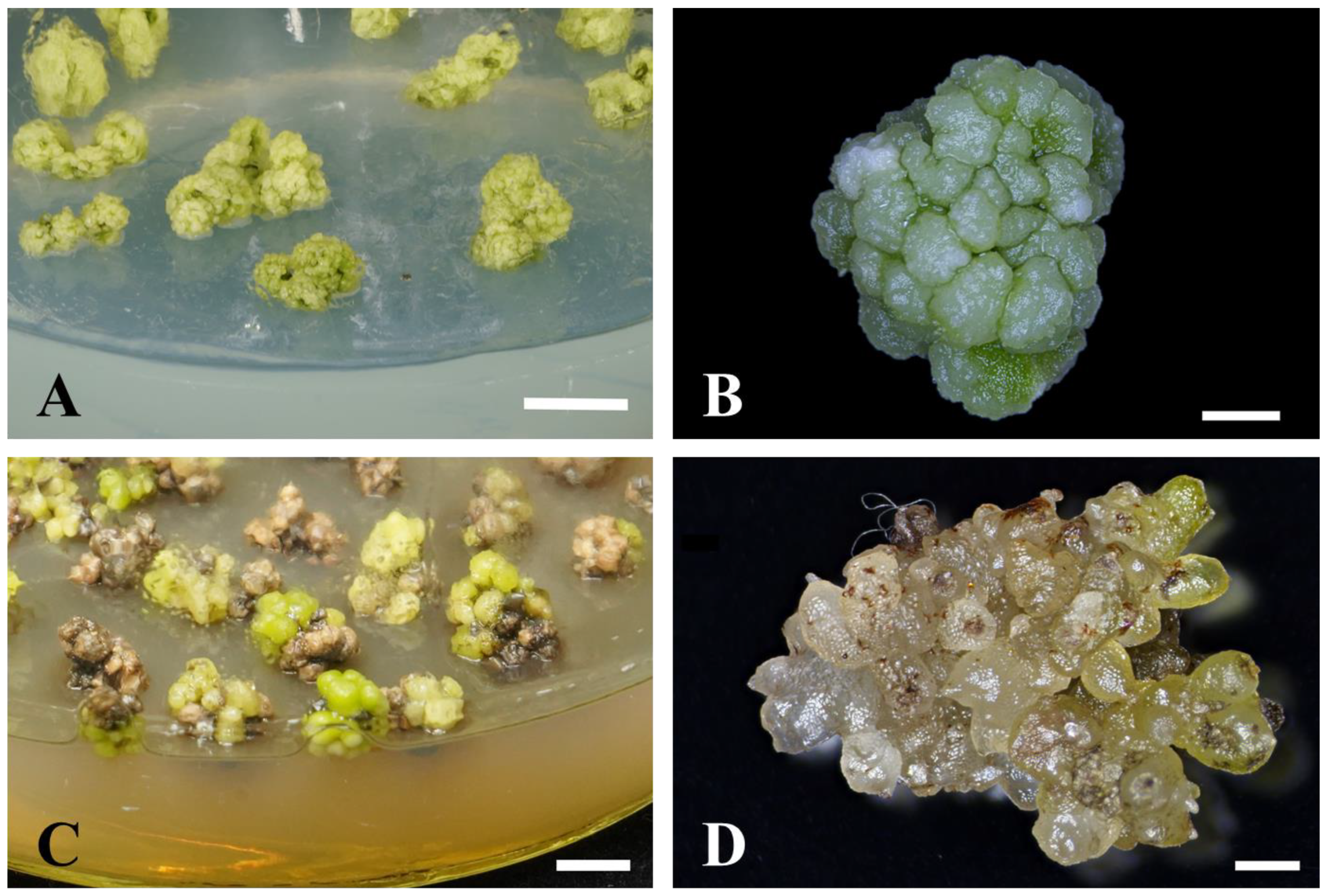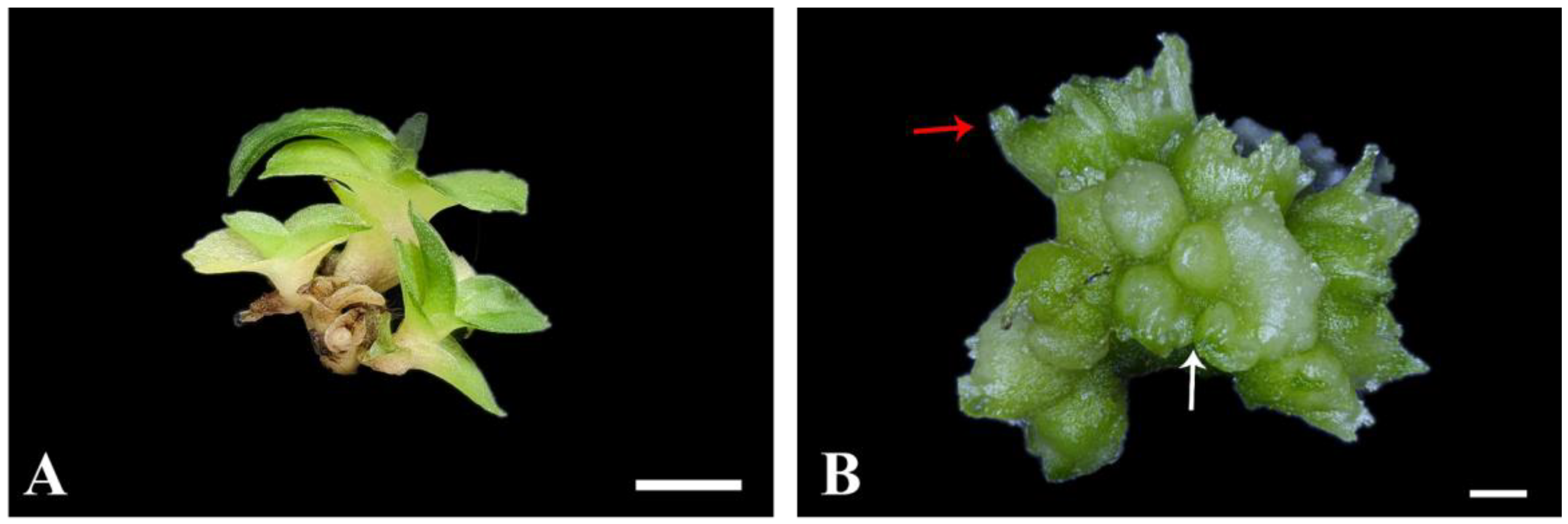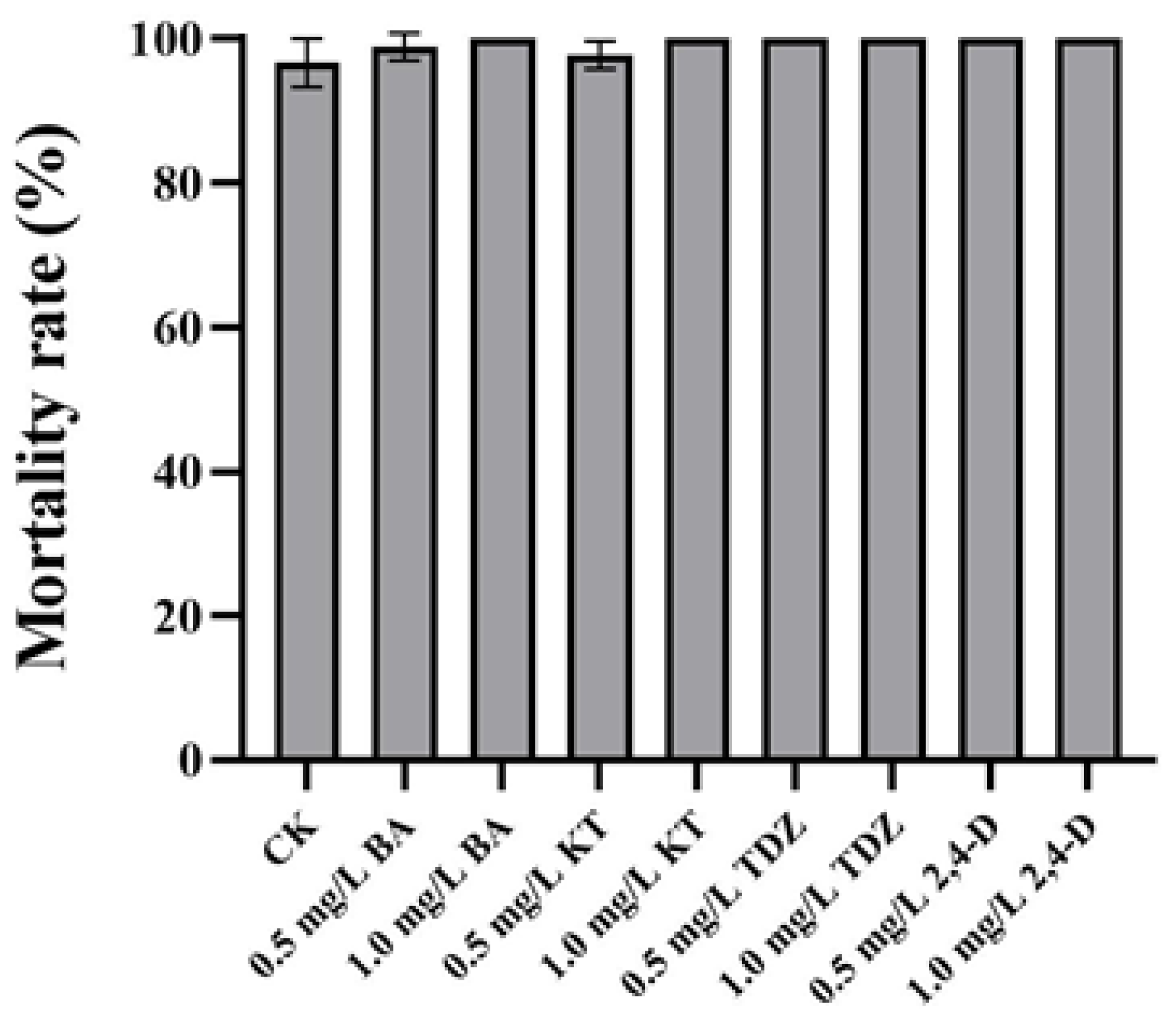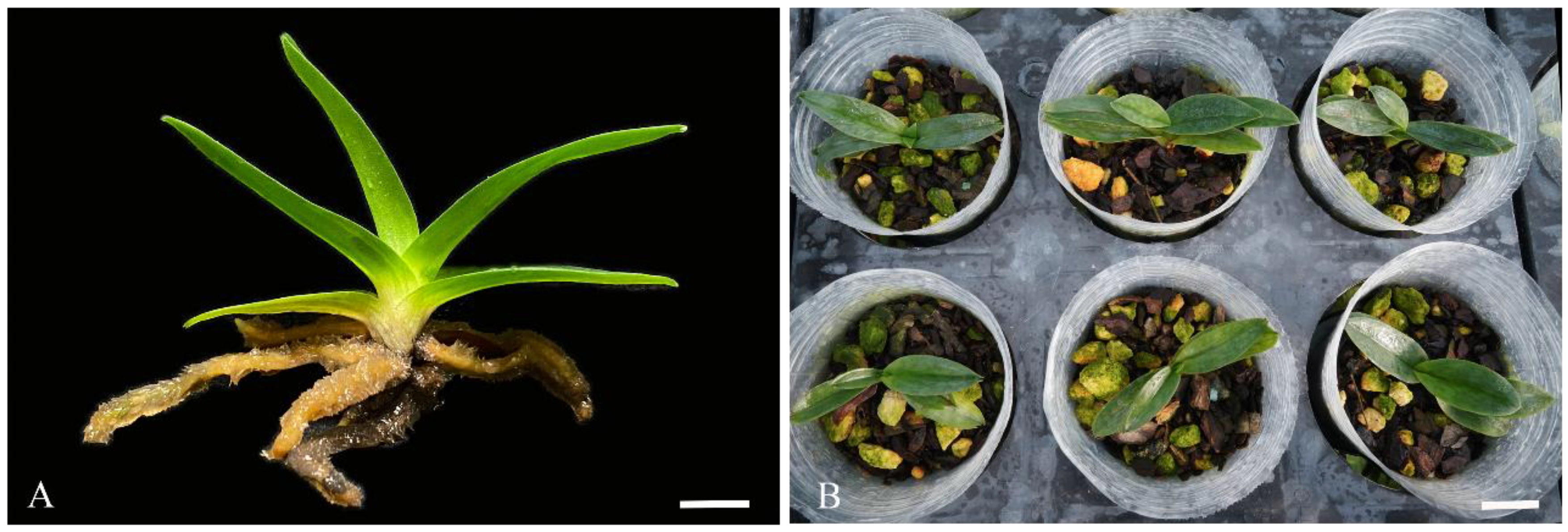Tissue Culture via Protocorm-like Bodies in an Orchids Hybrids Paphiopedilum SCBG Huihuang90
Abstract
:1. Introduction
2. Results
2.1. Callus Induction and Proliferation
2.2. Effect of 2,4-D and TDZ on PLB Proliferation
2.3. Effect of Different Media on the Differentiation of PLBs
2.4. Effect of 6-BA, TDZ, KT and 2,4-D on Cross-Cut Leaves of P. SCBG Huihuang90 in In Vitro Culture
2.5. Intact Leaves of Seedlings in In Vitro Culture

2.6. Root Induction and Seedlings Acclimatization
2.7. Change in Carbohydrate Content in the Regeneration of PLB Masses
3. Materials and Methods
3.1. Plant Material
3.2. Media Preparation and Culture Conditions of In Vitro Culture
3.3. Effect of 2,4-D and TDZ on Callus Culture
3.4. Effect of 2,4-D and TDZ on Proliferation of PLBs
3.5. Effect of Additive on Differentiation of PLBs
3.6. Effect of NAA on Root Induction
3.7. Cross-Cut and Intact Leaves of Seedlings in In Vitro Culture
3.8. Plantlet Acclimatization
3.9. Determination of Starch and Soluble Sugar Content
3.10. Histological Analysis
3.11. Data Analysis
4. Discussion
4.1. Callus Induction and Proliferation of Paphiopedilum
4.2. Propagation and Differentiation of PLBs of P. SCBG Huihuang90
4.3. Changes in Sugars during the Development of PLBs
Author Contributions
Funding
Institutional Review Board Statement
Data Availability Statement
Conflicts of Interest
References
- Zeng, S.; Huang, W.; Wu, K.; Zhang, J.; da Silva, J.A.; Duan, J. In vitro propagation of Paphiopedilum orchids. Crit. Rev. Biotechnol. 2016, 36, 521–534. [Google Scholar] [CrossRef] [PubMed]
- Luan, V.Q.; Huy, N.P.; Nam, N.B.; Huong, T.T.; Hien, V.T.; Hien, N.T.T.; Hai, N.T.; Thinh, D.K.; Nhut, D.T. Ex vitro and in vitro Paphiopedilum delenatii Guillaumin stem elongation under light-emitting diodes and shoot regeneration via stem node culture. Acta Physiol. Plant. 2015, 37, 136. [Google Scholar] [CrossRef]
- Lin, Y.H.; Chang, C.; Chang, W.C. Plant regeneration from callus culture of a Paphiopedilum hybrid. Plant Cell Tissue Organ Cult. 2000, 62, 21–25. [Google Scholar] [CrossRef]
- Liao, Y.J.; Tsai, Y.C.; Sun, Y.W.; Lin, R.S.; Wu, F.S. In vitro shoot induction and plant regeneration from flower buds in Paphiopedilum orchids. Vitr. Cell. Dev. Biol. Plant 2011, 47, 702–709. [Google Scholar] [CrossRef]
- Soonthornkalump, S.; Nakkanong, K.; Meesawat, U. In vitro cloning via direct somatic embryogenesis and genetic stability assessment of Paphiopedilum niveum (Rchb.f.) Stein: The endangered Venus’s slipper orchid. Vitr. Cell. Dev. Biol. Plant 2019, 55, 265–276. [Google Scholar] [CrossRef]
- Guo, B.; Zeng, S.; Yin, Y.; Li, L.; Ma, G.; Wu, K.; Fang, L. Characterization of phytohormone and transcriptome profiles during protocorm-like bodies development of Paphiopedilum. BMC Genom. 2021, 22, 806. [Google Scholar] [CrossRef] [PubMed]
- Hong, P.I.; Chen, J.T.; Chang, W.C. Plant regeneration via protocorm-like body formation and shoot multiplication from seed-derived callus of a maudiae type slipper orchid. Acta Physiol. Plant. 2008, 30, 755–759. [Google Scholar] [CrossRef]
- Cardoso, J.C.; Zanello, C.A.; Chen, J.-T. An overview of orchid protocorm-like bodies: Mass propagation, biotechnology, molecular aspects, and breeding. Int. J. Mol. Sci. 2020, 21, 985. [Google Scholar] [CrossRef]
- Lee, Y.; Hsu, S.; Yeung, E.C. Orchid protocorm-like bodies are somatic embryos. Am. J. Bot. 2013, 100, 2121–2131. [Google Scholar] [CrossRef]
- Yeung, E.C. A perspective on orchid seed and protocorm development. Bot. Stud. 2017, 58, 33. [Google Scholar] [CrossRef]
- Kundu, S.; Gantait, S. Thidiazuron-induced protocorm-like bodies in Orchid: Progress and prospects. In Thidiazuron: From Urea Derivative to Plant Growth Regulator; Ahmad, N., Faisal, M., Eds.; Springer: Singapore, 2018; pp. 273–287. [Google Scholar]
- Hossain, M.; Sharma, M.; da Silva, J.A.T.; Pathak, P. Seed germination and tissue culture of Cymbidium giganteum Wall. ex Lindl. Sci. Hortic. 2010, 123, 479–487. [Google Scholar] [CrossRef]
- Chen, J.T.; Chang, W.C. Direct somatic embryogenesis and plant regeneration from leaf explants of Phalaenopsis amabilis. Biol. Plant 2006, 50, 169–173. [Google Scholar] [CrossRef]
- Roy, J.; Naha, S.; Majumdar, M.; Banerjee, N. Direct and callus-mediated protocorm-like body induction from shoot-tips of Dendrobium chrysotoxum Lindl. (Orchidaceae). Plant Cell Tissue Organ Cult. 2007, 90, 31–39. [Google Scholar] [CrossRef]
- Ng, C.Y.; Saleh, N.M. In vitro propagation of Paphiopedilum orchid through formation of protocorm-like bodies. Plant Cell Tissue Organ Cult. 2011, 105, 193–202. [Google Scholar] [CrossRef]
- Luan, L.Q.; Uyen, N.H.P.; Ha, V.T.T. In vitro mutation breeding of Paphiopedilum by ionization radiation. Sci. Hortic. 2012, 144, 1–9. [Google Scholar] [CrossRef]
- Zeng, S.; Wang, J.; Wu, K.; da Silva, J.A.T.; Zhang, J.; Duan, J. In vitro propagation of Paphiopedilum hangianum Perner & Gruss. Sci. Hortic. 2013, 151, 147–156. [Google Scholar] [CrossRef]
- Masnoddin, M.; Repin, R.; Aziz, Z.A. Microprogation of an endangered Borneo Orchid, Paphiopedilum rothschildianum callus using temporary immersion bioreactor system. Thai Agric. Res. J. 2016, 34, 161–171. [Google Scholar] [CrossRef]
- Zeng, S.; Wu, K.; da Silva, J.A.T.; Zhang, J.; Chen, Z.; Xia, N.; Duan, J. Asymbiotic seed germination, seedling development and reintroduction of Paphiopedilum wardii Sumerh., an endangered terrestrial orchid. Sci. Hortic. 2012, 138, 198–209. [Google Scholar] [CrossRef]
- Murashige, T.; Skoog, F. A Revised Medium for Rapid Growth and Bio Assays with Tobacco Tissue Cultures. Physiol. plantarum. 1962, 15, 473–497. [Google Scholar] [CrossRef]
- Dale, P.; Deambrogio, E. A comparison of callus induction and plant regeneration from different explants of Hordeum vulgare. Z. Fur Pflanzenphysiol. 1979, 94, 65–77. [Google Scholar] [CrossRef]
- Long, B.; Niemiera, A.X.; Cheng, Z.Y.; Long, C.L. In vitro propagation of four threatened Paphiopedilum species (Orchidaceae). Plant Cell Tissue Organ Cult. 2010, 101, 151–162. [Google Scholar] [CrossRef]
- Berezina, E.V.; Brilkina, A.A.; Schurova, A.V.; Veselov, A.P. Accumulation of biomass and phenolic compounds by calluses Oxycoccus palustris Pers. and O. macrocarpus (Ait.) Pers. in the presence of different cytokinins. Russ. J. Plant Physiol. 2019, 66, 67–76. [Google Scholar] [CrossRef]
- Luo, J.P.; Wawrosch, C.; Kopp, B. Enhanced micropropagation of Dendrobium huoshanense CZ Tang et SJ Cheng through protocorm-like bodies: The effects of cytokinins, carbohydrate sources and cold pretreatment. Sci. Hortic. 2009, 123, 258–262. [Google Scholar] [CrossRef]
- Chen, L.Q.; Cheung, L.S.; Feng, L.; Tanner, W.; Frommer, W.B. Transport of sugars. Annu. Rev. Biochem. 2015, 84, 865–894. [Google Scholar] [CrossRef] [PubMed]
- Eveland, A.L.; Jackson, D.P. Sugars, signalling, and plant development. J. Exp. Bot. 2012, 63, 3367–3377. [Google Scholar] [CrossRef] [PubMed]
- Halford, N.G.; Curtis, T.Y.; Muttucumaru, N.; Postles, J.; Mottram, D.S. Sugars in crop plants. Ann. Appl. Biol. 2011, 158, 1–25. [Google Scholar] [CrossRef]
- Fortes, A.M.; Pais, M.S. Organogenesis from internode-derived nodules of Humulus lupulus var. Nugget (Cannabinaceae): Histological studies and changes in the starch content. Am. J. Bot. 2000, 87, 971–979. [Google Scholar] [CrossRef]
- Palama, T.L.; Menard, P.; Fock, I.; Choi, Y.H.; Bourdon, E.; Govinden-Soulange, J.; Bahut, M.; Payet, B.; Verpoorte, R.; Kodja, H. Shoot differentiation from protocorm callus cultures of Vanilla planifolia (Orchidaceae): Proteomic and metabolic responses at early stage. BMC Plant Biol. 2010, 10, 82. [Google Scholar] [CrossRef]




| Culture Medium | Differentiation Rate (%) | Mortality (%) |
|---|---|---|
| CK | 82.22 ± 0.91 a | 17.78 ± 1.28 e |
| 0.5 mg/L 2,4-D | 82.96 ± 1.39 a | 17.04 ± 1.96 e |
| 1.0 mg/L 2,4-D | 69.63 ± 2.62 b | 30.37 ± 3.70 d |
| 1.5 mg/L 2,4-D | 16.30 ± 3.43 d | 83.70 ± 4.86 b |
| 2.0 mg/L 2,4-D | 0 ± 0 e | 100.00 ± 0.00 a |
| 0.5 mg/L TDZ | 70.37 ± 1.89 b | 29.63 ± 2.67 d |
| 1.0 mg/L TDZ | 60.00 ± 0.91 c | 40.00 ± 1.28 c |
| 1.5 mg/L TDZ | 7.41 ± 1.39 e | 92.59 ± 1.96 a |
| 2.0 mg/L TDZ | 0 ± 0 e | 100.00 ± 0.00 a |
| Culture Medium | Proliferation Coefficient of PLB Mass | Mortality (%) | |
|---|---|---|---|
| 2,4-D (mg/L) | TDZ (mg/L) | ||
| 0.00 | 0.00 | 2.66 ± 0.11 d | 1.85 ± 0.93 c |
| 0.01 | 4.66 ± 0.17 c | 2.78 ± 0.56 c | |
| 0.025 | 5.76 ± 0.29 a | 2.78 ± 0.69 c | |
| 0.05 | 5.04 ± 0.22 b | 3.47 ± 0.69 c | |
| 0.025 | 1.96 ± 0.49 d | 16.67 ± 7.22 b | |
| 0.05 | 2.10 ± 0.09 d | 13.89 ± 5.00 b | |
| 0.10 | 1.99 ± 0.06 d | 15.28 ± 2.28 b | |
| 0.25 | 2.82 ± 0.13 c | 13.89 ± 1.39 b | |
| 0.50 | 2.93 ± 0.08 c | 18.06 ± 2.78 b | |
| 0.75 | 2.28 ± 0.20 d | 30.56 ± 6.05 a | |
| 0.05 | 0.50 | 1.27 ± 0.08 e | 27.78 ± 0.67 a |
| Culture Medium | Differentiation Rate (%) | Number of Differentiated Shoots | Browning Rate (%) |
|---|---|---|---|
| CK | 33.33 ± 1.53 c | 8.67 ± 0.28 bc | 55.56 ± 2.10 c |
| 0.5 g/L AC | 37.41 ± 1.54 c | 9.42 ± 0.22 b | 20.99 ± 1.63 e |
| 0.25 mg/L KT | 32.10 ± 2.23 c | 8.26 ± 0.27 c | 94.44 ± 1.07 a |
| 0.5 mg/L KT | 39.58 ± 3.18 c | 7.81 ± 0.25 c | 96.11 ± 0.28 a |
| 0.25 mg/L BA | 39.51 ± 2.69 c | 8.67 ± 0.18 bc | 85.19 ± 1.07 b |
| 0.5 mg/L BA | 59.25 ± 3.85 b | 8.04 ± 0.37 c | 88.27 ± 1.63 b |
| 10% CW (v/v) + 0.5 g/L AC | 70.63 ± 2.10 a | 14.33 ± 0.32 a | 29.37 ± 2.10 d |
| NAA (mg/L) | Percentage of Rooting Explants (%) | Average Length of the Root (cm) | Mean No. of Roots PerExplant |
|---|---|---|---|
| 0 | 53.33 ± 0.67 b | 1.63 ± 0.08 b | 2.96 ± 0.06 b |
| 0.1 | 54.00 ± 3.06 b | 1.74 ± 0.04 b | 2.86 ± 0.03 b |
| 0.5 | 64.00 ± 2.00 a | 2.06 ± 0.03 a | 3.22 ± 0.19 a |
| 1.0 | 60.74 ± 0.74 a | 1.73 ± 0.08 b | 3.00 ± 0.03 ab |
| 2.0 | 60.67 ± 2.04 a | 1.80 ± 0.06 b | 3.14 ± 0.07 ab |
| Growth Stage | Soluble Sugar Content (mg/g) | Starch Content (mg/g) |
|---|---|---|
| Callus | 21.95 ± 0.55 c | 51.15 ± 0.78 b |
| PLB mass | 50.22 ± 0.71 a | 69.73 ± 0.41 a |
| Mixture of shoots and PLBs | 26.02 ± 0.27 b | 69.74 ± 0.44 a |
| Shoots | 21.46 ± 0.27 c | 52.58 ± 0.54 b |
Disclaimer/Publisher’s Note: The statements, opinions and data contained in all publications are solely those of the individual author(s) and contributor(s) and not of MDPI and/or the editor(s). MDPI and/or the editor(s) disclaim responsibility for any injury to people or property resulting from any ideas, methods, instructions or products referred to in the content. |
© 2024 by the authors. Licensee MDPI, Basel, Switzerland. This article is an open access article distributed under the terms and conditions of the Creative Commons Attribution (CC BY) license (https://creativecommons.org/licenses/by/4.0/).
Share and Cite
Guo, B.; Chen, H.; Yin, Y.; Wang, W.; Zeng, S. Tissue Culture via Protocorm-like Bodies in an Orchids Hybrids Paphiopedilum SCBG Huihuang90. Plants 2024, 13, 197. https://doi.org/10.3390/plants13020197
Guo B, Chen H, Yin Y, Wang W, Zeng S. Tissue Culture via Protocorm-like Bodies in an Orchids Hybrids Paphiopedilum SCBG Huihuang90. Plants. 2024; 13(2):197. https://doi.org/10.3390/plants13020197
Chicago/Turabian StyleGuo, Beiyi, Hong Chen, Yuying Yin, Wei Wang, and Songjun Zeng. 2024. "Tissue Culture via Protocorm-like Bodies in an Orchids Hybrids Paphiopedilum SCBG Huihuang90" Plants 13, no. 2: 197. https://doi.org/10.3390/plants13020197
APA StyleGuo, B., Chen, H., Yin, Y., Wang, W., & Zeng, S. (2024). Tissue Culture via Protocorm-like Bodies in an Orchids Hybrids Paphiopedilum SCBG Huihuang90. Plants, 13(2), 197. https://doi.org/10.3390/plants13020197






